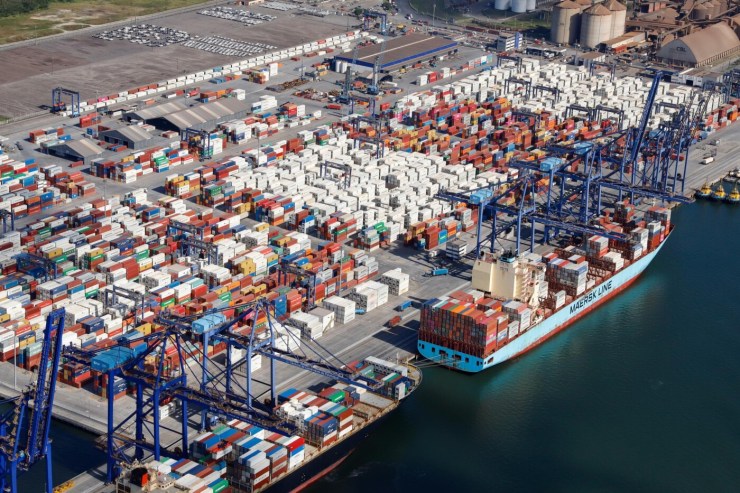At the beginning of the year, Brazilian pork exports were expected to grow throughout 2025, but first-half figures exceeded all expectations. Fresh pork shipments between January and June 2025 totaled more than 630,000 tons and valued at US$1.626 billion, representing an increase of 19.2% (+101,400 tons) in volume and 34.8% (+US$$ 419.4 million) in revenue, compared to the same period last year. Highlights included the increased share of the Philippines and Japan and the decline in purchases by China (Table 1).

Table 1 – Brazilian exports of fresh pork by destination in the first half of 2025 (in tons and in US$) compared with the same period in 2024 – Prepared by Iuri P. Machado, with data from Secex
According to ABPA, Brazilian pork exports, considering all products, both fresh and processed, accumulated from January to June 2025, totaled 722 thousand tons, a volume 17.6% higher than that shipped in the same period of 2024; in revenue, exports, including processed products, reached US$1.723 billion, an increase of 32.6% compared to last year. Furthermore, according to ABPA, Santa Catarina led shipments in the first half of the year, with 374.3 thousand tons (growth of 11% compared to the same period last year), followed by Rio Grande do Sul, with 158.9 thousand tons (+21,29%), Paraná, with 111.3 thousand tons (+38,81%), Mato Grosso, with 18.5 thousand tons (+5,46%) and Minas Gerais, with 18.4 thousand tons (+54,71%).
Analyzing shipments of fresh pork in 2025, month by month, in all of them the exported volumes were a record compared to previous years, and for the first time in history, between February and June, more than 100 thousand tons were shipped per month in five consecutive months (table 2).

Table 2 – Exported volumes of Brazilian fresh pork (in tons), month by month, in 2021, 2022, 2023, 2024 and from January to June 2025 – Prepared by Iuri P. Machado, with data from Secex
June 2025 not only saw the highest monthly export volume of the year, but also saw the rise of the Japanese market, taking third place in terms of tonnage and maintaining second place in terms of revenue. Meanwhile, China and Hong Kong continue to reduce purchases from Brazil (Table 3).

Table 3 – Brazilian exports of fresh pork by destination in June 2025 (in tons and in US$) compared with June 2024 – Prepared by Iuri P. Machado, with data from Secex
On July 9, Trump announced a 501-pound tariff increase on imports from Brazil, effective August 1. What impact will this have on the pig industry?
Brazil exports relatively little pork to the US. In 2024, only 18,400 tons of fresh pork were exported, representing less than 1.5% of total exports. In the first half of 2025, only 7,400 tons (1,17% of the total) were exported. On the other hand, the United States is the second-largest export destination for beef, representing around 12% of shipments of this protein. The day after the announcement, the CEPEA/ESALQ indicator for the price of fed cattle fell by almost five reais, remaining below 300 reais per arroba in São Paulo (chart 1). According to Cepea, the impact of this news compounded the weak pace of domestic beef sales, resulting in slow sales of animals for slaughter and weakening animal and meat prices.

Chart 1 – Live Cattle Indicator – CEPEA/ESALQ (R$/@) in São Paulo/SP, DAILY, in the last 30 business days, up to July 15, 2025. Price indicated in the chart refers to July 10, 2025, the day after the announcement of the US tariff of 50% on Brazilian exports – Source: CEPEA
Pork, despite successive turbulence with other proteins, first with the outbreak of bird flu in RS and now with the 50% tariff affecting beef more, has maintained relative stability in prices (table 4 and graphs 2 and 3), although it has experienced two consecutive weeks of price drops in some markets (table 4).
According to CEPEA, demand for pork is low in the domestic market, which can be attributed to reduced demand during the school holidays, a situation that should lead to further falls in prices by the end of the month.

Table 4 – Weekly price of the Belo Horizonte Pork Exchange (BSEMG) in 2025 (R$/kg live), up to the meeting of July 17, 2025. Blue highlights for upward movement and yellow for downward movement – Prepared by Iuri P. Machado, with data from BESEMG

Chart 2 – LIVE PIG Indicator – CEPEA/ESALQ (R$/kg) in MG, PR, RS, SC and SP, daily, in the last 12 months, until July 15, 2025. Prices indicated in the chart refer to the month of June/25 – Source: CEPEA

Chart 3 – SPECIAL PORK CARCASS Indicator – CEPEA/ESALQ (R$/kg) in São Paulo/SP, monthly, in the last 12 months. Average from July/25 to July 15, 2025 – Source: CEPEA
Corn and soybean meal prices continue to fall, and the exchange rate for pork as the main input is very favorable.
On the 10th, CONAB released its tenth survey for the 2024/25 harvest, adding nearly 4 million tons of corn compared to the previous survey. For the second harvest alone, the entity projects a volume of 104.5 million tons, totaling more than 132 million tons for the three national harvests of the 2024/25 period. With less than 50% of the harvested area, the price of the grain continues to fall (graphs 4 and 5), with private consultants projecting an even larger harvest than CONAB's estimate. In Mato Grosso, corn is already undersold, with R$ 40.00 per 60 kg bag.

Graph 4 – Average daily price of CORN (R$/SC 60kg) in CAMPINAS-SP, in the last 60 business days, until July 15, 2025 – Source: CEPEA

Graph 5 – Average daily price of CORN (R$/SC 60kg) in CAMPINAS-SP, in the last 24 months, until July 15, 2025 – Source: CEPEA
While soybean oil is increasingly valued, primarily due to the growing demand for biodiesel, soybean meal prices remain low, hovering around R$ 1,500 per ton in some markets. The high price ratio between degummed soybean oil and soybean meal (surpassing 4:1) is quite striking, confirming the high demand for soybean oil, which ultimately increases the supply of soybean meal, as it is derived from crushing soybeans for oil production (Table 5). Until this ratio declines significantly, there is no room for significant increases in soybean meal prices.

Table 5 – Average monthly price of soybean meal and degummed oil (R$/ton) and oil:soybean meal ratio, in RIO VERDE (GO), in 2023, 2024 and 2025 (*until 07/15/25) – Prepared by Iuri P. Machado, with data from AGIGO
This drop in the value of the main inputs, even with fluctuations in pork prices, has allowed an excellent exchange rate for live pigs with the corn + soybean meal mix (graph 6) and determined better financial margins than last year (table 6).

Chart 6 – Exchange rate for PORK: MIX corn + soybean meal (R$/kg) in São Paulo, from July 23 to July 25 (until July 15, 25). Ideal exchange rate, above 5.00. Composition of the MIX: for each kilogram of MIX, 740g of corn and 260g of soybean meal – Prepared by Iuri P. Machado with data from CEPEA – prices for the state of São Paulo

Table 6 – Total costs (full cycle), sales price and estimated profit/loss, monthly, in the three southern states and half-yearly in Goiás (R$/kg live pig sold) from January to June 2025 and the annual average of 2022, 2023 and 2024 – Prepared by Iuri P. Machado with data: Embrapa (costs), Cepea (pork price)
According to ABCS president Marcelo Lopes, the expected significant increase in US import tariffs has already caused turbulence in several Brazilian production chains even before it came into effect or any diplomatic negotiations. "After all, an increase of 50% significantly reduces competitiveness in a very important market. Although the pig industry will not be directly affected, it is important to monitor the movements of the beef market, which was most affected by the measure and was already showing a downward trend in prices before the tariff announcement." He also explains that a decline in beef cattle prices could be a key factor in limiting the rise in pork prices. "On the other hand, costs have helped the activity, and producers should be aware of the window of opportunity to purchase inputs, especially corn," he concludes.





